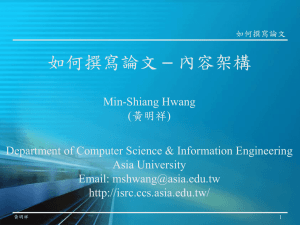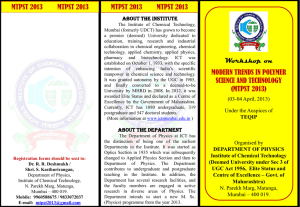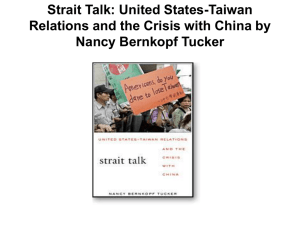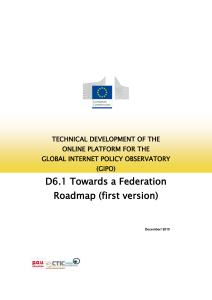Prof. WK Choi (蔡永傑) GIPO/EE, National Taiwan University
advertisement
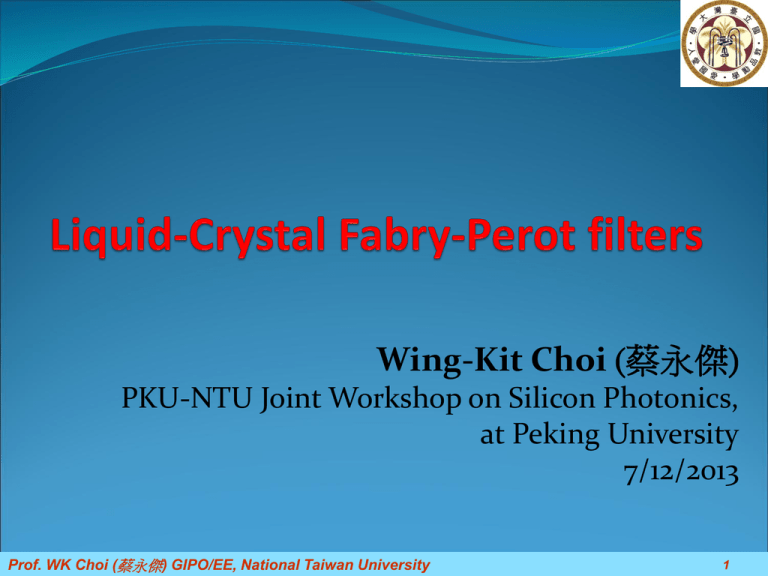
Wing-Kit Choi (蔡永傑) PKU-NTU Joint Workshop on Silicon Photonics, at Peking University 7/12/2013 Prof. WK Choi (蔡永傑) GIPO/EE, National Taiwan University 1 Outline 1. Introduction to LC 2. Introduction to PDLC/nano-PDLC 3. Introduction to LCFP filters Prof. WK Choi (蔡永傑) GIPO/EE, National Taiwan University 2 Liquid Crystal (LC) A mainstream technology for today’s displays Prof. WK Choi (蔡永傑) GIPO/EE, National Taiwan University 3 Advantages of LC technology Low voltage / low power consumption Large electro-optic effects/Large birefringence No moving part / Reliable Long life Robust Compact Easily scaled to large area / large number of pixels, etc Prof. WK Choi (蔡永傑) GIPO/EE, National Taiwan University 4 What are Liquid Crystals ? Intermediate between crystalline solid and amorphous liquid Usually found in organic molecules with: Highly anisotropic shapes, e.g. rod or disc shape Intermolecular forces: Crystals > Liquid crystals > Liquid Liquid Crystal Crystalline Solid Amorphous Liquid temperature Prof. WK Choi (蔡永傑) GIPO/EE, National Taiwan University 5 Intermediate properties Fluid properties of liquids + Optical properties of solids Crystalline Solid • Highly ordered • Cannot flow • Optically anisotropic Liquid Crystal • Some degree of order • Can flow • Optically anisotropic 6 Prof. WK Choi (蔡永傑) GIPO/EE, National Taiwan University Amorphous Liquid • Highly disordered • Can flow easily • Optically isotropic What so attractive about LCs ? Crystals Optical properties + Liquids Fluid properties Liquid Crystals Optical anisotropy + Molecules can be re-arranged easily by electric fields Large electro-optic effects are possible with only small applied voltages ! 7 Prof. WK Choi (蔡永傑) GIPO/EE, National Taiwan University Slow response of LC (nematic) Turn-ON is Fast (can be < 1ms) Electric field driven Turn-OFF is Slow (e.g. tens of ms) Non-electric field driven weak restoring force of LC molecules A major limitation of LCs Prof. WK Choi (蔡永傑) GIPO/EE, National Taiwan University 8 How to achieve a faster LC response time ? Use of different LC Phase Modified Electrode Design Different LC Mode Polymer/LC e-o effects Thinner cell gap Over-Drive schemes Dual frequency, etc Prof. WK Choi (蔡永傑) GIPO/EE, National Taiwan University 9 Introduction to PDLC • LC droplets dispersed in a solid polymer matrix • Most common method to produce PDLC: Polymerization-Induced Phase Separation (PIPS) 1. 2. 3. 4. Mix LC with monomers Cure the mixture with UV light Polymerization occurs LC droplets form 2013/6/26 Prof. WK Choi (蔡永傑) GIPO/EE, National Taiwan University 10 Operation principle V=0 neff. > np Scattering (Dark state) Prof. WK Choi (蔡永傑) GIPO/EE, National Taiwan University V > Vth neff. = np Transmission (Bright state) 11 Advantages High Optical efficiency (No polarizers) Ease of Fabrication (No Alignment layers) Potentially Lower cost (No Alignment layers) Compatible with plastic substrates to form Flexible Displays Polarization Independent (in normal direction) Fast Response time possible (esp. nano-PDLC) Prof. WK Choi (蔡永傑) GIPO/EE, National Taiwan University 12 Applications Electrically Switchable Windows Other possible applications: Variable Optical Attenuators (VOAs) Project Displays Reflective/ Flexible Displays Tunable lens, etc Prof. WK Choi (蔡永傑) GIPO/EE, National Taiwan University 13 Transmission vs cell gap Thicker LC cell more scattering CR , V 0.9 0.8 Transmittance (%) 0.7 0.6 5um 0.5 7.5um 12um 0.4 15um 0.3 19um 0.2 23um 0.1 0 0 10 20 Voltage (V) 30 Prof. WK Choi (蔡永傑) GIPO/EE, National Taiwan University 40 50 14 Nano PDLC @ High Polymer concentration 0.9 Polymer % , Scattering , CR (droplet size ) Polymer > ~ 70%, ~ no scattering (droplet size ~100nm) Known as nano-PDLC 0.8 0.7 Transmittance (%) ~ 50% polymer Max. scattering highest CR (droplet size ~ 1m ) 70% 0.6 0.5 50% 0.4 60% 60% 70% 0.3 0.2 50% 0.1 Prof. WK Choi (蔡永傑) GIPO/EE, National Taiwan University 0 0 20 40 Voltage (V) 60 80 100 15 Nano PDLC Fast Response (<1ms) possible 30 Polymer % , Response time (droplet size ) Polymer > ~ 70% (nanoPDLC), fast response < 1ms possible response time (ms) Polymer interaction with LC stronger (more surface/volume ratio) 25 20 15 10 5 0 50 55 60 65 70 75 concentration of polymer (wt%) 2013/6/26 Prof. WK Choi (蔡永傑) GIPO/EE, National Taiwan University 16 Prof. WK Choi (蔡永傑) GIPO/EE, National Taiwan University 17 Fabry-Perot cavity Air ( or e.g. Liquid Crystal) Incident light T : transmittance R : reflectance n’ : the refractive index of the material d’ : the thickness of the etalon Transmitted light Highly reflective mirror (with glass substrate) Prof. WK Choi (蔡永傑) GIPO/EE, National Taiwan University 18 Wavelength tuning Tuning =~ 50nm Prof. WK Choi (蔡永傑) GIPO/EE, National Taiwan University 19 LCFP filters First Proposed by a group at Rockwell Int. Science Centre, US, 1981 (Gunning et al) To employ large n of LC: Highly efficient wavelength tunable filters Visible and Infrared Applications Lower Voltage Wider tuning range compared to other solid e-o materials Prof. WK Choi (蔡永傑) GIPO/EE, National Taiwan University 20 LCFP filters Since 1990, further improved by groups at e.g. : 1) Bell Core , NJ ( Patel et al) 2) NTT Optoelectronics, Japan (Hirabayashi et al) for WDM in telecommunications with Lower Loss, narrow bandwidth (<1-2nm), wide tunable range Prof. WK Choi (蔡永傑) GIPO/EE, National Taiwan University 21 LCFP (using PA-LC) Spectrum with Pol. And without Pol. Wavelength tuning ne no (Bellcore ,1990) Prof. WK Choi (蔡永傑) GIPO/EE, National Taiwan University 22 LCFP (Polarization Independent) Split into 2 components by Calcite Spectrum vs V without Pol. (Bellcore, 1991) Prof. WK Choi (蔡永傑) GIPO/EE, National Taiwan University 23 LCFP (Polarization Independent) At > ~2.5V , ne and no modes merge Spectrum vs V without Pol. POLARIZER GLASS LC GLASS POLARIZER (Bellcore,1991) Prof. WK Choi (蔡永傑) GIPO/EE, National Taiwan University 24 High speed LCFP using FLC High speed (<100s) Binary Bistable (Bellcore,1993) Prof. WK Choi (蔡永傑) GIPO/EE, National Taiwan University 25 High speed LCFP using DHFLC High speed (< ~ 100 s) Low Voltage May have hysteresis effect (Cambridge, 1996) Prof. WK Choi (蔡永傑) GIPO/EE, National Taiwan University 26 High speed LCFP using Sm*A LC High speed (<10 s) High Voltage Elevated temp. Tilted alignment (complicated) (Colorado, 1996) Prof. WK Choi (蔡永傑) GIPO/EE, National Taiwan University 27 Thank You!! Wing-Kit Choi (蔡永傑) National Taiwan University wkchoi@cc.ee.ntu.edu.tw Tel: +886-2-3366-3669 Prof. WK Choi (蔡永傑) GIPO/EE, National Taiwan University 28




